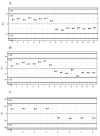Gene expression in acute Stanford type A dissection: a comparative microarray study
- PMID: 16824202
- PMCID: PMC1557406
- DOI: 10.1186/1479-5876-4-29
Gene expression in acute Stanford type A dissection: a comparative microarray study
Abstract
Background: We compared gene expression profiles in acutely dissected aorta with those in normal control aorta.
Materials and methods: Ascending aorta specimen from patients with an acute Stanford A-dissection were taken during surgery and compared with those from normal ascending aorta from multiorgan donors using the BD Atlas Human1.2 Array I, BD Atlas Human Cardiovascular Array and the Affymetrix HG-U133A GeneChip. For analysis only genes with strong signals of more than 70 percent of the mean signal of all spots on the array were accepted as being expressed. Quantitative real-time polymerase chain reaction (RT-PCR) was used to confirm regulation of expression of a subset of 24 genes known to be involved in aortic structure and function.
Results: According to our definition expression profiling of aorta tissue specimens revealed an expression of 19.1% to 23.5% of the genes listed on the arrays. Of those 15.7% to 28.9% were differently expressed in dissected and control aorta specimens. Several genes that encode for extracellular matrix components such as collagen IV alpha2 and -alpha5, collagen VI alpha3, collagen XIV alpha1, collagen XVIII alpha1 and elastin were down-regulated in aortic dissection, whereas levels of matrix metalloproteinases-11, -14 and -19 were increased. Some genes coding for cell to cell adhesion, cell to matrix signaling (e.g., polycystin1 and -2), cytoskeleton, as well as several myofibrillar genes (e.g., alpha-actinin, tropomyosin, gelsolin) were found to be down-regulated. Not surprisingly, some genes associated with chronic inflammation such as interleukin -2, -6 and -8, were up-regulated in dissection.
Conclusion: Our results demonstrate the complexity of the dissecting process on a molecular level. Genes coding for the integrity and strength of the aortic wall were down-regulated whereas components of inflammatory response were up-regulated. Altered patterns of gene expression indicate a pre-existing structural failure, which is probably a consequence of insufficient remodeling of the aortic wall resulting in further aortic dissection.
Figures

References
-
- Raghunath M, Nienaber C, Kodolitsch Y. 100 Jahre Marfan-Syndrom-eine Bestandsaufnahme. Dt Ärztebl. 1997;94 A-821/B-681/C-637.
LinkOut - more resources
Full Text Sources
Research Materials

